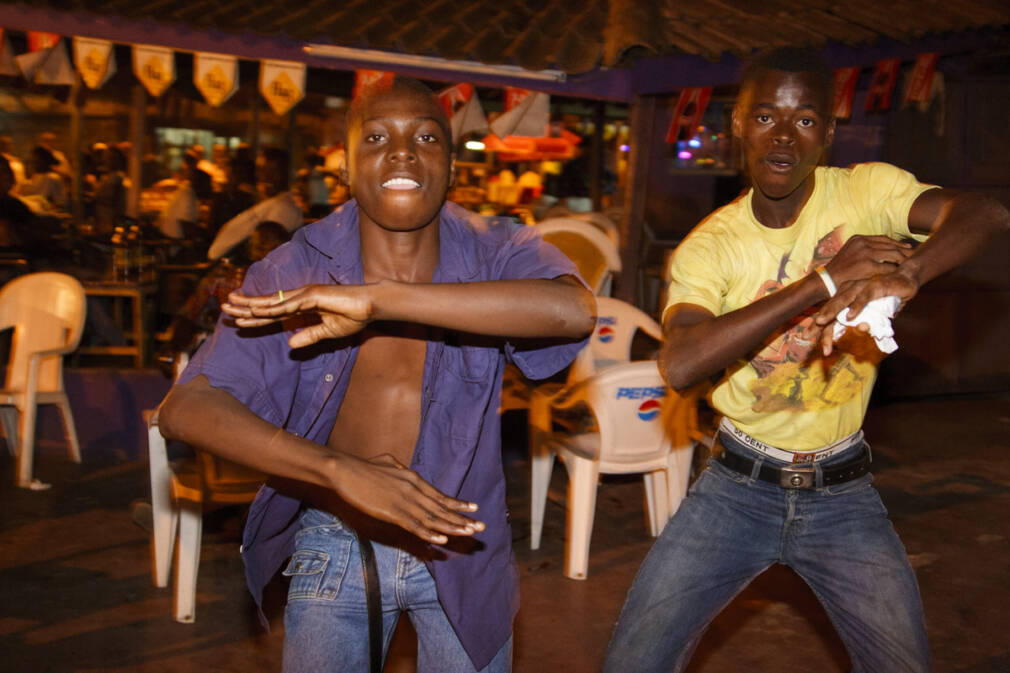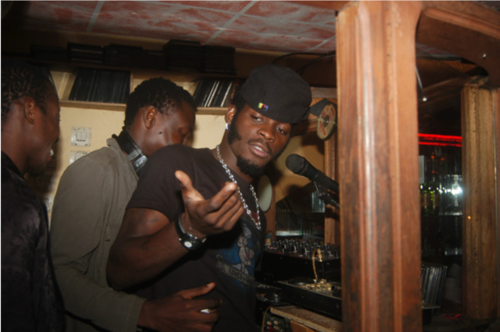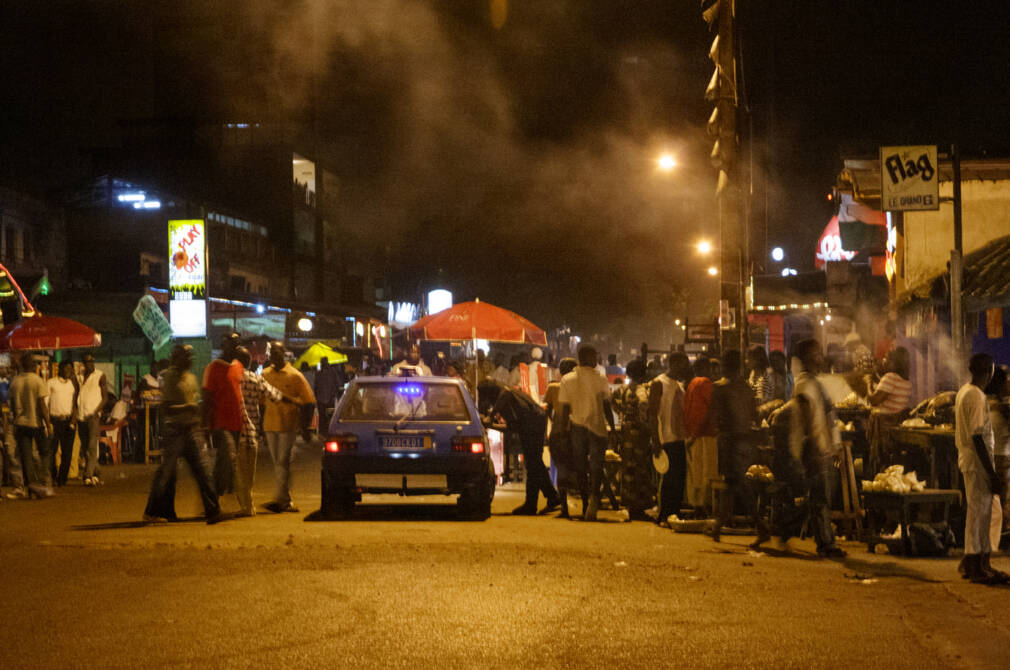On August 6th, 2011, a few months after the end of a violent post-electoral crisis, Abidjan’s new government demolished the Rue Princesse on the grounds that it had become unsanitary, crippled with prostitution, drug trafficking and incessant brawls around the maquis (open-air bars) and nightclubs. Yet, for twenty years, this huge festive artery in the Yopougon district had been considered a cultural showcase of Ivorian music and one of the most important nightlife spots in West Africa. Now in the midst of a renaissance, let’s take a look back at the history of what Abidjaners still refer to simply as “the street”.
L’Image (“The Image”) was the district’s first nightclub, opening on December 18th, 1991, under the impetus of two well-known Ivorian music producers: Constant Anagonou and Claude Bassolé. They teamed up with DJ Ben In The Booth and venue manager Jean-Charles Gouessé, aka “Charlie Nice-Eyes”. The latter, a testament to the close connections maintained by their team with the Ivorian showbiz scene, is a definitive element behind the venue’s success:
“We had a strategy: if the club was packed with lots of celebrities, the business would work. So we called Yves Zogbo Junior and Consty Eka, who were hosts for the AfriCar Music Awards and the Saturday night TV show ‘Afrique Étoile’. We asked them to send their guests to our club after the show. So, just after watching ‘Afrique Étoile’, people in Yopougon would discover Wenge Musica, Papa Wemba, Koffi Olomidé… Artists from all over the world were coming to Ivory Coast, and they inevitably would drop by our club.”
As soon as 1992, DJ Ben opened his own maquis, La Clinique (“The Clinic”), just a few steps from L’Image, so that customers could have a place to meet before the club opened. He was soon followed by other investors, who founded the maquis Le Sérum (“The Serum”) and La Farmacie 2 Garde (“Late-night Pharmacy”), whose names refer to the original function of this portion of the street – L’Image being built on the site of a former pharmacy. The streetlife also attracted prostitutes who posted up near the maquis, leading the clients of L’Image to name the street after Henri Duparc’s 1992 movie Rue Princesse, telling the story of a young prostitute whose lover urges her to become a singer.
Zougloumania
In the first half of the 1990s Abidjan was a buzz in its fight for a multi-party system and freedom of expression. Students were at the forefront of these protests, and it was in the midst of these struggles that a new musical genre emerged at the Yopougon university campus: “zouglou”. Although Didier Bilé and his group Les Parents du Campus (“Campus Parents”) are credited with inventing the genre, it was almost simultaneously that a number of entertainment groups from working-class neighborhoods would convert to it: Les Potes de la Rue, Les Côcôs, Esprit de Yop, and Zougloumania. As Claude Bassolé quickly foresaw the impact this new music could have, he became one of the first producers of the genre, and DJ Ben one of the first disc-jockeys to play these bands’ tracks on the decks at L’Image. Meanwhile, Rue Princesse continued to grow, establishing itself as a mecca for cultural promotion. TV host Barthelemy Inabo opened Le Laser, whose stage offered a space to hear the hits that zouglou bands played on his Variétoscope broadcast program. Industrial entrepreneur Chao Mao transformed his maquis Le Sérum into a full on nightclub – Le Magnum – and opened the street’s first “giant maquis”, Get 27, a sort of open-air nightclub, which would soon become the norm in following years. From 1995 onwards, cultural agent Alain Bidi organized CarnaYop, a festival showcasing Ivorian culture: music, of course, but also crafts, theater and gastronomy. As complaints from local residents began to amass, the Yopougon mayor Doukouré Mustapha stepped in to defend it. He gave his official blessing to the development of Rue Princesse, which then seemed unstoppable.

At the end of the 1990s, a new generation of maquis and nightclubs replaced the previous ones: the venues were equipped with state-of-the-art loudspeakers, increasing their capacities to almost 1,000 people, and attracting the best DJs in the capital and even the Congo: Erikson le Zulu, Shegal Mokonzi, TV5. The latter compete in dexterity during their performances: it’s the heyday of the atalaku (tributes) sung in Lingala and the “designer label dances”, during which the DJs comment on outfits of the most fashionable customers. The Rue Princesse takes on the shape it will maintain until its destruction: a kilometer-long artery, crowded from nightfall onwards, where the noise from sound systems of adjoining bars cuts through a joyous din, where young and old get drunk together, “kill” tables (piling beer crates up on them) and dance long after daybreak. It was in this environment that street DJs gained international recognition, enabling them to migrate to Paris. They took over the turntables at Sunday night African parties at Atlantis (quai d’Austerlitz) and Nelson (Montreuil). It was in these nightclubs that a group of young Ivorian party-goers known as the “Boucantiers” (shoe-makers) or the “Jet Set” met newcomer DJs.
Dressed in designer Italian outfits, these youngsters invent dance steps, show off by ostentatiously throwing banknotes at the DJs and the audience – a signature gesture they call “le travaillement” (“the hustle”) – ordering champagne and smoking 30cm-long Cuban cigars. They have their names sung by the DJs, film their evening and have it broadcast on VHS cassettes back in Abidjan’s Rue Princesse. David Monsoh, then already well established in the music scene as a producer for Koffi Olomidé and Fally Ipupa, today recounts:
“On Sundays, we used to meet up at Nelson and Atlantis, and I’d see a bunch of young people. It’s the crew with Douk Saga, Lino Versace, Boro Sangui, Molare, Serge Defalet and others. They call themselves the Boucantiers. At that time, DJ Jacob played Congolese music with a very danceable ‘tac-tac, tac-tac’ rhythm, and he would take away the singer’s vocals. And so he would do the atalaku: ‘Today we’ve got the great David Monsoh, we’ve got Douk Saga.’ So these guys would catch my attention. I approached them, they were having fun, handing out money… And I told them: ‘Now let’s create a concept: you’re gonna be singers.’ And they all turned me down.”
One step back, two steps forward…
In December 1999, Côte d’Ivoire’s first coup d’état marked the start of a decade of politico-military crises, enhanced by the calamitous elections of 2000, which saw Laurent Gbagbo seize power, followed by the armed rebellion that divided the country in two between 2002 and 2007. The post-electoral crisis of 2011 concluded this long sequence.
While the Rue Princesse would regularly be subject to curfews from 7pm to 6am, the maquis kept their doors open during the day, from 10am onwards, where crowds flock to find a seat. Nightclubs, meanwhile, organized all-nighters, requiring customers to enter before 7pm and stay up inside until the early hours – a very special way of respecting the curfew. It was during this troubled period for Ivory Coast that Rue Princesse made its mark, continuing to attract customers from all over the world despite the crisis.
In 2002, the Boucantiers returned to Ivory Coast, where their fame had already been established by their widespread Parisian adventures. In the meantime, they reinvented themselves as singer-artists, although none of them could sing, they eventually accepted the advances of David Monsoh. With the help of David and of Fadiga de Milano, a major zouglou producer and distributor, they recorded their first coupé-décalé track: “Sagacité”, written by Douk Saga. Their return to Abidjan did not go unnoticed, with night owls flocking from bar to bar to see the new Ivorian attraction, sometimes also hoping to pick up a few banknotes the crew would throw in the crowd.
The DJs who initially promoted coupé-décalé in the Rue Princesse became singer-songwriters themselves, taking advantage of their privileged platform to make a name for themselves. The biggest stars of the genre, after the members of the Jet-Set, have almost all frequented DJ booths of the famous street: DJ Arafat, DJ Mulukuku and Ramzy Werrason worked at the Shangaï, DJ Kerozen at the Ministère de la Joie, Francky Dicaprio at the Must Bar and then the Get 27, Debordo Leekunfa at La Nouvelle Écriture… Both Debordo Leekunfa and DJ Arafat started out as bar cleaners before working up to the turntables. Freddy Kouyaté, manager of La Nouvelle Écriture, explains:
“Debordo started out as a caviste [handing out drinks to the waiters], and then one evening he said to me, ‘Old man, can I clean inside afterwards?’ I told him there were already enough people to clean the maquis. But he’s got something on his mind, and as he insists, I say ok. He would wake up early in the morning to come to the maquis and then he would act as if he’s sweeping the floor. When he’s done, he would turn on the turntables and practice. Then, one day, the kid surprises me. It’s Tabaski day, and I’m doing my preparations. Everyone is ready… In the audience I’ve got Vetcho Dillinger, Senator [A’Salfo], Hamed Bakayoko… And all my DJs come to see me, ‘Old man, your kid wants to sing’.‘Which kid?’, I reply. ‘Debordo!’ I tell them, ‘Are you crazy or what? Do you see those sitting there?’ In the end, they said, ‘OK old chap, we’ll give you the hat [the recipe] then’. I said, ‘Ok, give him the microphone’. That very day, the tough guys from Abidjan were there! It was Tabaski! But the kid is a killer! I had goosebumps, I had never heard a voice like that. He sang until everyone was overwhelmed… Money goes that way!”
A hotbed of cultural promotion in the 1990s, the Rue Princesse became the place where talent was forged in the following decade. This was the place where some DJs, like Arafat and Debordo, began their spectacular road to success.

The princess, between sun and rain
The great success of the street in the 2000s also aroused the curiosity of the political caste, who, in the midst of the Ivorian crisis, found a means of asserting a popular foothold. President Laurent Gbgabo himself visited the street twice: the first time discreetly with the USA ambassador at La Nouvelle Écriture, and the second time with former France’s minister of Culture Jack Lang, a visit widely reported by the national media.
The political peace of 2007-2010 gave Ivory Coast some breathing room. Although the Rue Princesse continued to attract customers, it would soon find itself competing with other venues in the capital, as other districts were unable to remain afloat in such a vivid scene. Marcory, in particular, stood out, with the so-called “1000 maquis” neighborhood, including the most famous of them all, Le Marcory Gazoil. In Yopougon, too, nightlife is diversifying away from the Rue Princesse. In Cocody, the historic bourgeois district, investors opened nightclubs in order to attract a new audience. Despite this, the original still retains its status as West Africa’s most festive street.
In 2011, after an eight-month long post-electoral crisis between Laurent Gbagbo and political adversary Alassane Ouattara, Ouattara took power and launched the operation “Clean Country”. Rue Princesse, in the heart of Yopougon, then a stronghold of Laurent Gbagbo’s supporters, was one of the first victims of this State-conducted operation, tearing out the hearts of those who had created it. Claude Bassolé, co-owner of L’Image, testifies:
“I was dismayed because it was the only place that brought everyone together. In other words, when someone came from Paris, London or New York, the first place they wanted to visit was Rue Princesse. I think the street contributed so much… Some people talk about debauchery, but the truth is, we had such a good time on this street, and it fed a lot of people. That was why we did it.”
Ten years later, at the very place where the old maquis was destroyed, new bars – not open-airs – took over the street: the Rex-Club, Café de Venise, and the Internat Night-Club. Myths are not so easily destroyed.




